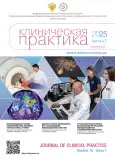Acute macular neuroretinopathy: clinical cases
- Authors: Zhazybaev R.S.1, Sorokin E.L.1,2, Zhirov A.L.1,2, Danilov O.V.1,2
-
Affiliations:
- The Khabarovsk Branch the S. Fyodorov Eye Microsurgery Federal State Institution
- Far-Eastern State Medical University
- Issue: Vol 16, No 1 (2025)
- Pages: 112-120
- Section: Case reports
- URL: https://journal-vniispk.ru/clinpractice/article/view/295975
- DOI: https://doi.org/10.17816/clinpract634366
- ID: 295975
Cite item
Abstract
BACKGROUND: Acute macular neuroretinopathy is a rare disease of the central retinal zone. CLINICAL CASES DESCRIPTION: The first clinical case represents a male patient aged 47 years with the complaints of a decreased vision acuity and developing a spot in the vision fields of the left eye. He was treated at the ophthalmology clinic due to acute central serous chorioretinopathy with no effect. At the moment of examination, his vision acuity in the left eye was 1.0, with the anterior segment showing no abnormalities, the ophthalmoscopy has not revealed any changes. According to the data from the optical coherence tomography of the macular zone, the findings included the changes in the reflectivity at the level of the external plexiform and the external nuclear layers. The diagnosis set was «Acute macular neuroretinopathy in the left eye», the recommendations included dynamic follow-up. The second description is a case of female patient aged 39 years, undergoing dynamic checkups due to the operated squamous carcinoma in the lower orbital wall on the right side and in the maxilla, s/p radiation therapy. The patient had no vision-related complaints, but the ophthalmoscopy of the right eye (at the macular zone para- and perifoveally) has revealed three «cotton-wool-like» exudates. According to the data from the optical coherence tomography, in the right eye, there were foci of hyperreflectivity at the level of the neural layer of retinal fibers along with the corresponding «cotton-wool-like» exudates, as well as juxtafoveally at the level of the external nuclear layer, which is characteristic for acute macular neuroretinopathy. CONCLUSION: The first clinical case shows the importance of multimodal diagnostics in cases of complaints of a decreased vision acuity and spots in the vision fields, despite the high acuity of central vision. The second clinical case demonstrates that radiation therapy, conducted in the areas adjacent to the eyeball, is capable of resulting in an impaired circulation in the capillary plexuses of the retina, including the superficial vascular complex and in the deep capillary plexus with the development of ischemic retinal manifestations.
Full Text
##article.viewOnOriginalSite##About the authors
Ruslan S. Zhazybaev
The Khabarovsk Branch the S. Fyodorov Eye Microsurgery Federal State Institution
Author for correspondence.
Email: rzhazybaev@gmail.com
ORCID iD: 0000-0002-6201-5051
SPIN-code: 9194-4972
Russian Federation, 211 Tikhookeanskaya st, Khabarovsk, 680033
Evgenii L. Sorokin
The Khabarovsk Branch the S. Fyodorov Eye Microsurgery Federal State Institution; Far-Eastern State Medical University
Email: nauka2khvmntk@mail.ru
ORCID iD: 0000-0002-2028-1140
SPIN-code: 4516-1429
MD, PhD, Professor
Russian Federation, 211 Tikhookeanskaya st, Khabarovsk, 680033; Khabarovsk, 680000Arkadiy L. Zhirov
The Khabarovsk Branch the S. Fyodorov Eye Microsurgery Federal State Institution; Far-Eastern State Medical University
Email: zhirovark@bk.ru
ORCID iD: 0000-0003-0226-9014
SPIN-code: 4674-1687
Russian Federation, 211 Tikhookeanskaya st, Khabarovsk, 680033; Khabarovsk, 680000
Oleg V. Danilov
The Khabarovsk Branch the S. Fyodorov Eye Microsurgery Federal State Institution; Far-Eastern State Medical University
Email: hard-n-haevy@mail.ru
ORCID iD: 0000-0002-6610-2419
SPIN-code: 9068-5429
Russian Federation, 211 Tikhookeanskaya st, Khabarovsk, 680033; Khabarovsk, 680000
References
- Bos PJ, Deutman AF. Acute macular neuroretinopathy. Am J Ophthalmol. 1975;80(4):573–584. doi: 10.1016/0002-9394(75)90387-6
- Yeh S, Hwang TS, Weleber RG, et al. Acute Macular Outer Retinopathy (AMOR): A reappraisal of acute macular neuroretinopathy using multimodality diagnostic testing. Arch Ophthalmol. 2011;129(3):360–371. doi: 10.1001/archophthalmol.2011.22
- Turbeville SD, Cowan LD, Gass JD. Acute macular neuroretinopathy: A review of the literature. Surv Ophthalmol. 2003;48(1):1–11. doi: 10.1016/s0039-6257(02)00398-3
- Teng Y, Teng YF. [The clinical characteristics and pathologic mechanisms of acute macular neuroretinopathy. (In Chinese)]. Zhonghua Yan Ke Za Zhi. 2019;55(4):311–315. doi: 10.3760/cma.j.issn.0412-4081.2019.04.016
- Bhavsar KV, Lin S, Rahimy E, et al. Acute macular neuroretinopathy: A comprehensive review of the literature. Surv Ophthalmol. 2016;61(5):538–565. doi: 10.1016/j.survophthal.2016.03.003
- Şekeryapan Gediz B. Acute macular neuroretinopathy in purtscher retinopathy. Turk J Ophthalmol. 2020;50(2):123–126. doi: 10.4274/tjo.galenos.2019.02488
- Fekri S, Khorshidifar M, Dehghani MS, et al. Acute macular neuroretinopathy and COVID-19 vaccination: Case report and literature review. J Fr Ophtalmol. 2023;46(1):72–82. doi: 10.1016/j.jfo.2022.09.008 EDN: RCWEPR
- Rahimy E, Sarraf D. Paracentral acute middle maculopathy spectral-domain optical coherence tomography feature of deep capillary ischemia. Curr Opin Ophthalmol. 2014;25(3):207–212. doi: 10.1097/ICU.0000000000000045
- Casalino G, Arrigo A, et al. Acute macular neuroretinopathy: Pathogenetic insights from optical coherence tomography angiography. Br J Ophthalmol. 2019;103(3):410–414. doi: 10.1136/bjophthalmol-2018-312197
- Garg A, Shah AN, Richardson T, et al. Early features in acute macular neuroretinopathy. Int Ophthalmol. 2014;34(3):685–688. doi: 10.1007/s10792-013-9850-3 EDN: IPKQFV
- Azar G, Wolff B, Cornut PL, et al. Spectral domain optical coherence tomography evolutive features in acute macular neuroretinopathy. Eur J Ophthalmol. 2012;22(5):850–852. doi: 10.5301/ejo.5000172
- Botsford BW, Kukkar P, Bonhomme G. Multimodal imaging in acute macular neuroretinopathy. J Neuroophthalmol. 2021;41(3):e357–e359. doi: 10.1097/WNO.0000000000001128
- Fawzi AA, Pappuru RR, Sarraf D, et al. Acute macular neuroretinopathy: Long-term insights revealed by multimodal imaging. Retina. 2012;32(8):1500–1513. doi: 10.1097/IAE.0b013e318263d0c3
- Gass JD, Agarwal A, Scott IU. Acute zonal occult outer retinopathy: A long-term follow-up study. Am J Ophthalmol. 2002;134(3):329–339. doi: 10.1016/s0002-9394(02)01640-9
- Rodman JA, Shechtman DL, Haines K. Acute macular neuroretinopathy: The evolution of the disease through the use of newer diagnostic modalities. Clin Exp Optom. 2014;97(5):463–467. doi: 10.1111/cxo.12161
Supplementary files














